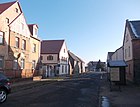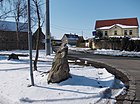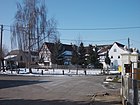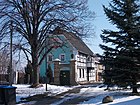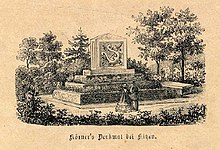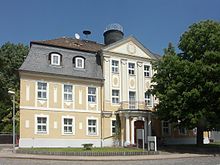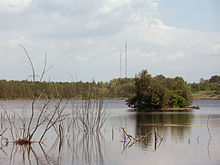Kitzen (Pegau)
|
Fawns
City of Pegau
|
||
|---|---|---|
| Coordinates: 51 ° 13 ′ 19 ″ N , 12 ° 13 ′ 24 ″ E | ||
| Height : | 142 m | |
| Area : | 26.94 km² | |
| Residents : | 1885 (Dec. 31, 2010) | |
| Population density : | 70 inhabitants / km² | |
| Incorporation : | January 1, 2012 | |
| Postal code : | 04523 | |
| Area code : | 034203 | |
|
Location of Kitzen in Saxony |
||
Kitzen is a district of the city of Pegau in the Leipzig district in Saxony . Before January 1, 2012, Kitzen was an independent municipality .
geography
location
Kitzen is located in the Leipzig lowlands , on the edge of the Leipziger Neuseenland and on the border with Saxony-Anhalt . The center of the village is located around 17 km southwest of downtown Leipzig and 18 km east of Weißenfels .
The village was bordered in the south by an already flooded open pit . To the east was the Zwenkau opencast mine. This was closed in 1999, and the Zwenkauer See is being created here . The neighboring towns are Markranstädt in the north, Leipzig and Zwenkau in the east and Pegau in the south . The border with Saxony-Anhalt runs in the west . The western districts were about 10 to 15 meters above the level of the others, which are at the level of the wide Elsteraue.
The Elsterfloßgraben , which runs from Crossen to Lützen and on to Bad Dürrenberg and Wallendorf and was used to transport wood from the Vogtland to the Merseburg and Leipzig areas from the 16th century, runs through the former municipal area.
traffic
The A 38 motorway runs through the former municipality of Kitzens . It can be reached via the Leipzig-Südwest junction . The B 186 , in the valley of the White Elster , runs east of the community.
Districts
The twelve districts of Kitzen are
- Fawns
- Hohenlohe
- Ice village
- Sittel
- Thesau
- Piss
- Praise
- Sea sail
- Advertise
- Parting
- Grand Schkorlopp
- Kleinschkorlopp
history
The beginnings
The area was first settled in the younger Stone Age (up to around 3000 BC), as is shown by finds from neighboring Eythra . At the turn of the ages , the Elbe Germans , for example the Hermunduren tribe, were found in the area . From the 6th century onwards, Slavic tribes settled here, presumably assimilating the remaining Germanic population, and which continued until the 9th / 10th. Populated the region in the 19th century. In the 9th century, in the course of the German eastward expansion, the slow displacement by the Franks began. The Saale formed the border between the Franks (west) and the Sorbs (east). The term Sorbs was probably used as a collective term for various Slavic tribes. In the period that followed, the Sorbs were displaced by immigrating Franks, Thuringians, Bavaria and Flemings, and by the end of the 13th century the German settlement of the area was complete.
Kitzen was first mentioned in a document in 1073 in a monastery pamphlet that speaks of battles between Wiprecht von Groitzsch and "Fridericus de Cutze" (Kitzen).
The church in Hohenlohe was built around 1150. In addition to Kitzen, almost all of today's districts of the community (except Werben) and a number of villages that no longer exist today belonged to the church district Hohenlohe. This was the largest district of the Merseburg Abbey , and a largely independent church and secular self-administration developed. There was also a Cistercian monastery , but it was moved to Leipzig before 1230 and became the St. Georg monastery there . In 1235 the district lost its independence. In 1277, Margrave Dietrich von Landsberg sold the Eisdorf court seat to the bishop of the Merseburg Monastery, Friedrich I von Torgau . These included the villages of Kitzen, Scheidens, Zitschen and Eythra. Kitzen remained connected to the Merseburg diocese until the 19th century.
Kitzen in Saxony
With the Reformation , which also took hold in the area around Kitzen, the secular power of the diocese ended, and after a transitional period the territory came to Electoral Saxony as the Hochstift Merseburg in 1565 and was the Duchy of Saxony-Merseburg from 1656 to 1738 . As another area, it did not belong to any of the seven districts of Electoral Saxony , but had the usual division of offices. The current districts of Kitzen were subordinate to the Hochstift-Merseburg office of Lützen, except for advertising . Advertising was in the administrative office of Pegau .
Under Elector August I, the Elsterfloßgraben was created in 1577 to transport timber from the Vogtland , which also led through the area around Kitzen. Little is known about the Kitzen region about the following time, as the area was badly affected in the Thirty Years War . What is certain is that the area was looted several times and almost all buildings were destroyed. Many residents died as a result of the war and the rampant plague. After the end of the war in 1648, the reconstruction got under way only slowly. It was not until the mid-1960s that the villages were halfway built up again.
In 1646 the leak of a spring was reported in a place belonging to today's Seegel district. This soon gained fame beyond the region as a source of healing and health. Even the Dresden court had the water delivered in barrels. Although the source is said to have dried up in the meantime, it retained its importance up to modern times. In 1898 a well house was built over the spring and a tavern on the road between Sittel and Werben was used to distribute the water, which was marketed privately until the 1970s and then until 1984 by the Konsum beverage combine. Leipzig artists lived in the buildings from 1994 to 2004, arranged by the Leipzig City Cultural Office. Since 2013 there are guest rooms, a holiday apartment and an event room. A spring water-fed Kneipp path with a barefoot path was laid out next to the fountain house.
In 1755 the Hohenloher Church, which burned down in 1714, was rebuilt. However, it fell into disrepair again in 1785 and had to be renovated again. In 1786 the community donated a wooden altar that is still preserved today.
From 1806 the region was badly affected by the Wars of Liberation . Many communities were burdened financially by billeting Napoleonic troops. But Kitzen was not directly involved in the war until the spring of 1813 at the Battle of Großgörschen , which left a field of rubble. In mid-June 1813, the Lützow Freikorps , in which Theodor Körner also fought, was attacked by Napoleonic troops due to a delay in an agreed troop withdrawal despite an armistice near Kitzen. 105 Lützowers fell, 90 were captured and 300 fled, including Lützow and the seriously injured Körner, who dragged himself to Großzschocher , about 11 km away . Various monuments in the region bear witness to these days.
Kitzen in Prussia
At the Congress of Vienna , Saxony lost substantial parts of its territories to Prussia. From 1815 these belonged to the Prussian province of Saxony . The eleven part of the Office Lutzen places to fawns came to the western part of the Office Lutzen and the place Advertise, the only become Prussian place of the Office Pegau, in 1816 to Merseburg in the administrative district of Merseburg .
Separation and detachment took place in the 19th century . It freed the peasants from their centuries of dependency. Furthermore, the field marks of the communities were changed. The boundaries were straightened and redefined through division and swap. In several villages, new exits were created and new paths were built. It was stipulated that the residents must maintain the paths. In addition, the taxes to be paid to the church were reorganized. The schools, previously financed by taxes from the residents, now received their funds proportionally from the community purse.
At the beginning of the 20th century, the municipal roads were paved piece by piece. From 1911 the villages around Kitzen were gradually connected to the electricity network.
Members from 26 Kitzen families moved into the First World War . The Great Depression and World War II brought further suffering. Military clashes only broke out in Kitzen in the last month of the war. On April 18, 1945, American soldiers marched into Kitzen. At the beginning of July the Americans withdrew and Kitzen became part of the Soviet zone of occupation .
After 1945
From September 1945 the land reform was implemented. Large landowners were expropriated. In Kitzen this only applied to the manor . On November 23, the land was divided into 59 Kitzeners. The same procedure was followed in the surrounding communities. Numerous war refugees and displaced persons from eastern Germany came to the region , which in 1946 made up around a third of the population. These were housed in the manor or forcibly with Kitzen families. Cultural life slowly returned to normal: at the end of the 1940s there was the Kitzen folk choir, an amateur play group, a mandolin group, a small animal breeders' association and various dance bands.
Kitzen now belonged to the state of Saxony-Anhalt that was created in 1947 .
Kitzen in the GDR
It remained that way even after the GDR was founded in 1949. In 1950, in a community reform, smaller villages were merged into larger communities. These were Kitzen, Scheidens and Schkorlopp, which now belonged to the Weißenfels district . In 1952 the states were dissolved and the districts founded. Kitzen and the surrounding area came to the Leipzig-Land district in the Leipzig district .
Since 1950 there were local statutes for fawns. In the same year a commission was formed to re-regulate the numbering of houses, and in 1952 streets in the municipality were named that had not yet been named.
In 1949 the machine rental station (MAS) was created, which was renamed the machine-tractor station (MTS) in 1952. Here the farmers could borrow machines for cultivating the fields.
From 1952 to 1960 the small farms were integrated into agricultural production cooperatives (LPG). Those who did not voluntarily become members of the cooperative were put under massive pressure. In 1960 all individual farmers were organized in 14 cooperatives in the municipality. By 1978 these cooperatives gradually merged to form the LPG plant production “Progress” and the two LPG animal production “20. Anniversary of the GDR ”and“ Theodor Körner ”together.
In 1952 the old mansion was converted into a cultural center. There were dance evenings, cinema and theater performances. A library was also set up in the house. In 1956 a branch of the folk music school and in 1957 a restaurant were opened. Until 1961, the park at the Kulturhaus was designed as a recreation center with benches and trees. Since 1981 the inhabitants have been celebrating the Kitzener Whitsun beer again and since 1983 there has been a village and children's festival in Werben.
After 1990
With the establishment of the Free State of Saxony in 1990, Kitzen and the Leipzig district again belonged to Saxony. In 1994 Kitzen, Scheidens and Schkorlopp merged to form the Kitzen municipality.
In 1992/93 the cultural center was renovated and then housed the municipal administration as the town hall. The LPGs became Agrarprodukte Kitzen e. G.
Necessarily, the roads and all supply and disposal lines have also been renewed in recent years. The open pit pit Werben was renatured and the raft ditch was revived.
On January 1, 2012 Kitzens incorporated into the city of Pegau.
The Kitzener (Hohenloher) Church of St. Nikolai is worth seeing. A support association has taken on the monument and started the renovation. The first successes include the drainage, the renovation of the south portal and the start of the roof renovation.
Incorporations
Hohenlohe was incorporated between 1925 and 1939. Eisdorf, Sittel and Thesau were incorporated on July 1, 1950. Scheidens and Schkorlopp finally joined on January 1, 1994.
Schkorlopp was a community that was created on July 1, 1950 by merging the forerunner communities Großschkorlopp and Kleinschkorlopp.
Scheidens again probably incorporated Peißen in 1947 and Löben, Seegel and Werben on July 1, 1950.
On January 1, 2012, Kitzen was incorporated into the city of Pegau.
Sons and daughters of the former parish
- Rudolph Sack (1824–1900), agricultural machinery manufacturer in Leipzig , born in Kleinschkorlopp
Web links
- Kitzen on the website of Pegau
- Kitzen (Pegau) in the Digital Historical Directory of Saxony
- Kitzen (Pegau) . In: August Schumann : Complete State, Post and Newspaper Lexicon of Saxony. 4th volume. Schumann, Zwickau 1817, p. 600 f.
Individual evidence
- ^ Karlheinz Blaschke , Uwe Ulrich Jäschke : "Kursächsischer Ämteratlas", Leipzig 2009, ISBN 978-3-937386-14-0 , p. 84 f.
- ^ Karlheinz Blaschke , Uwe Ulrich Jäschke : "Kursächsischer Ämteratlas", Leipzig 2009, ISBN 978-3-937386-14-0 , p. 62 f.
- ^ The district of Merseburg in the municipal directory 1900
- ↑ StBA: Area changes from January 1st to December 31st, 2012




